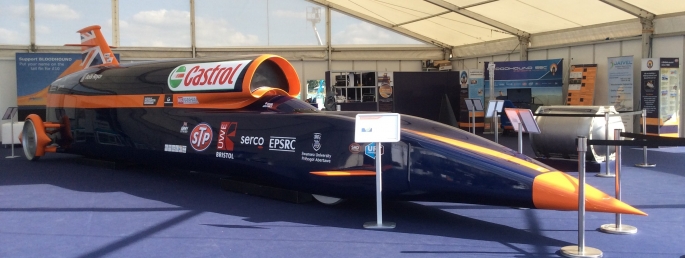Bloodhound at Farnborough5 July 2016 | Admin
The BLOODHOUND Project is at Farnborough International Airshow this week, courtesy of Rolls-Royce, whose EJ200 jet engine will be used, in conjunction with a hybrid rocket, to power the Land Speed Racing car to 1000mph (1,609km/h) in 2016. You can meet the team in the BLOODHOUND Pavilion - J4 BLOODHOUND SSC is a unique fusion of fast jet, space and F1 technologies, so it is fitting that a full size replica of the car is on display, in the Rolls-Royce pavilion, at the heart of the show. The build of the vehicle itself is well advanced with significant milestones being achieved recently, as detailed below. The Project is on-course for the finished car to roll-out for low speed testing (up to 200mph, 321km/h) at Newquay’s Aerohub in Summer 2015. BLOODHOUND will then fly to South Africa’s Hakskeen Pan for the start of the Land Speed Record campaign, that Autumn. BLOODHOUND SSC may be the most powerful land vehicle in the world, with c. 47,000lbs of thrust, equivalent to the combined output of 180 F1 cars, but going fast is not its primarily role. Rather, it is designed to inspire a generation by showcasing science and engineering in the most exciting and accessible way possible. With aerospace being such an important aspect of the UK economy, and future skills a key concern, government and the UK’s high-value manufacturing sector endorse BLOODHOUND’s mission. The car is being assembled in the BLOODHOUND Technical Centre in Avonmouth, Bristol. In simple terms it comprises of a carbon-fibre monocoque front section joined to a steel, aluminium and titanium rear chassis. Last week saw the upper chassis being test fitted to the lower chassis and cockpit section. This part of the car is constructed like an aircraft fuselage, with aluminum ribs, titanium stringers and body panels. The EJ200 jet hangs from a single mounting point on this upper chassis, above the car’s rocket motor, made by Nammo, a supplier to the European Space Agency based in Norway, which is mounted within the steel trellis lower structure. Carbon front and metallic rear sections went together smoothly so the BLOODHOUND Build Team has now commenced final assembly, which will see them bonding the titanium skin to the rear chassis with the help of 11,500 aerospace- grade rivets. BLOODHOUND SSC will not only be the fastest car in the world, it also needs to be the strongest to withstand the enormous forces generated by its power plants, supersonic air flow and 90kg solid aluminum wheels spinning at 10,200 rpm or 175 times per second. The first of those wheels was last month tested in a spin-rig at Rolls-Royce’s Derby base. Normally used to test turbines from jet engines, the facility provided the ideal means of evaluating how much the solid metal wheel would expand and heat up when travelling 1000mph. Project engineers are working through the data but early signs are that we have the right design for what will be the fastest wheels in history. The Project recently unveiled the completed carbon fibre monocoque that will be driver Andy Green’s supersonic office in 2015 and 2016. Andy, an RAF Wing Commander, has drawn on his unique experience of flying fast jets and driving World Land Speed Record winners Thrust SSC and JCB Dieselmax to design the dashboard and cockpit layout. Good ergonomics are vital given that BLOODHOUND SSC will cover a mile in 3.6 seconds, or 150m in the (300 millisecond) blink of an eye. The central screen shows the speed in miles per hour and Mach number (Mach 1 being the speed of sound), calculated by GPS, plus jet engine and rocket outputs. Dynamic speed indicators help Andy to judge when to fire the rocket and deploy the braking systems. Wheel loads are also given prominence. BLOODHOUND does not use aerodynamic down force, as a Formula 1 car does, while lift at the nose or rear axle must also be avoided at all costs. The need to carefully balance forces throughout its 1000mph speed range is one of the major reasons why shaping the Car has taken 30 design-years. The left-hand screen shows hydraulic pressures and temperatures in the braking and airbrake systems, while the one to Andy’s right provides information about the three engines, including temperatures, pressures and fuel levels. Together, the EJ200 jet engine and Nammo rockets produce around 210 kN (21 tonnes) of thrust, and Andy will monitor their status at key points during each run. BLOODHOUND’s dash also features two precision-engineered analogue Rolex instruments: a chronograph with built-in stopwatch, and a speedometer graduated up to 1,100mph (1,770km/h). The speedometer is a vital back-up to allow the Car to be stopped safely should the digital dashboard fail, while the chronograph will help to time the start-up and cool-down of the jet, and help to monitor the performance of other systems. Tested to withstand the severe vibration at 1,000 mph and the desert heat, these bespoke Rolex instruments are unique to BLOODHOUND SSC. BLOODHOUND has an acrylic windscreen custom-made by PPA Group. The plastic is heated, stretched and then two layers are bonded together to create a 25mm section, thicker than a fighter jet’s windscreen and sufficient to withstand an impact with a 1kg bird at 900mph (1,448km/h). Due to the oblique angle the windscreen is set at, the driver will in fact be looking through 50mm of curved plastic. The key challenge has therefore been to make the screen robust while maintaining absolute visual clarity. The BLOODHOUND Project is grateful for the support of a raft of world-class companies who share our ambition to inspire a generation to follow science and engineering by building, and racing, the most extraordinary Car in the world. Source : Bloodhound Website/Blog |
|
   |
